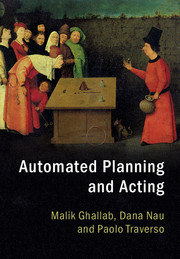Book contents
- Frontmatter
- Dedication
- Contents
- List of Algorithms
- Table of Notation
- Foreword
- Preface
- 1 Introduction
- 2 Deliberation with Deterministic Models
- 3 Deliberation with Refinement Methods
- 4 Deliberation with Temporal Models
- 5 Deliberation with Nondeterministic Models
- 6 Deliberation with Probabilistic Models
- 7 Other Deliberation Functions
- 8 Concluding Remarks
- Appendix A Search Algorithms
- Appendix B Strongly Connected Components of a Graph
- Bibliography
- Index
4 - Deliberation with Temporal Models
Published online by Cambridge University Press: 05 August 2016
- Frontmatter
- Dedication
- Contents
- List of Algorithms
- Table of Notation
- Foreword
- Preface
- 1 Introduction
- 2 Deliberation with Deterministic Models
- 3 Deliberation with Refinement Methods
- 4 Deliberation with Temporal Models
- 5 Deliberation with Nondeterministic Models
- 6 Deliberation with Probabilistic Models
- 7 Other Deliberation Functions
- 8 Concluding Remarks
- Appendix A Search Algorithms
- Appendix B Strongly Connected Components of a Graph
- Bibliography
- Index
Summary
This chapter is about planning and acting approaches in which time is explicit in the descriptive and operational models of actions, as well as in the models of the expected evolution of the world. It describes several algorithms and computation methods for handling durative and concurrent activities with respect to a predicted dynamics.
The first section addresses the need of making time explicit in the deliberation of an actor. A knowledge representation for modeling actions with temporal variables is presented in Section 4.2. It relies on an extension of the refinement methods introduced earlier, which are seen here as chronicles, that is, collections of assertions and tasks with explicit temporal constraints.A planning algorithm with temporal refinement methods is developed in Section 4.3.The basic techniques formanaging temporal constraints and the controllability of temporal plans are then presented in Section 4.4.Acting problems with temporal domain models are discussed, considering different types of operational models, in Section 4.5. The chapter concludes with a discussion and historical remarks, followed by exercises.
INTRODUCTION
To perform an action, different kinds of resources may need to be borrowed (e.g., space, tools) or consumed (e.g., energy). Time is a resource required by every action, but it differs from other types of resources. It flows independently from whether any actions are being performed, and it can be shared ad infinitum by independent actors as long as their actions do not interfere with each other.
In previous chapters, we left time implicit in our models: an action produced an instantaneous transition from one state to the next.However, deliberative acting often requires explicit temporal models of actions.Rather than just specifying an action's preconditions and effects, temporal modelsmust specify what things an action requires and what events it will cause at various points during the action's performance. For example, moving a robot r1 from a loading dock d1 to a loading dock d2 does not require d2's availability at the outset but does require it shortly before r1 reaches d2.
Actions may, and sometimes must, overlap, even if their conditions and effects are not independent. As one example, r1 may move from d1 to d2 while r2 is moving from d2 to d1.As another, opening a door that has a knob and a spring latch that controls the knob requires two tightly synchronized actions: (i) pushing and maintaining the latch while (ii) turning the knob.
- Type
- Chapter
- Information
- Automated Planning and Acting , pp. 114 - 154Publisher: Cambridge University PressPrint publication year: 2016



